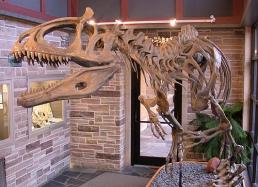Antarctic Fossils
Some of the first Antarctic fossils ever found weren’t discovered by a paleontologist at all. Captain Robert F. Scott—the famed British explorer who died during his 1911-12 South Pole expedition—collected about 40 pounds (18 kg) of rock containing fossilized seed ferns.
These specimens proved that Antarctica had once been warm enough to support plant life. But more than 50 years would pass before the discovery of an amphibian fossil jaw showed that animals had thrived there, too.
Proof of Pangaea
Since Scott's initial finds, scientists have found hundreds of amphibian and reptile fossils in several sites near the Beardmore and Shackleton Glaciers. Many of these specimens date to the Early Triassic period, 250 – 245 million years ago.
During the 1970s, work on these Early Triassic fossils revealed that some are the same species as those found from the same time period on other continents—proof that these land masses had all once been connected together to form Pangaea, a super-continent and “superhighway” for migrating animals.
Fossil finds during the 1980s and 1990s showed that by the Middle Triassic period, 245 – 235 million years ago, some species were unique to Antarctica. Apparently, resources had become abundant enough to sustain permanent populations, and over time, these animals had gradually evolved and adapted to the local environment.
The Initial Dinosaur Discoveries
In 1990-91, scientists made the first discoveries of dinosaur fossils in the central Transantarctic Mountains of Antarctica. A site on Mt. Kirkpatrick, near the Beardmore Glacier, yielded the bones of Cryolophosaurus ellioti, a species wholly new to science. Alongside this specimen were the bones of a pterosaur (flying reptile), a tritylodont (mammal-like reptile), and another dinosaur later recognized as the new species Glacialisaurus hammeri.
All proved to be unique to Antarctica—evidence that by this point in time, barriers were preventing populations from exchanging genes across Pangaea. Additional excavations in 2003 on Mt. Kirkpatrick uncovered more bones of Cryolophosaurus at the original site, and bones of another Glacialisaurus (or perhaps a new dinosaur species) at a new site. Storms cut short the excavations of these quarries, leading to plans for the 2010-11 expedition.




